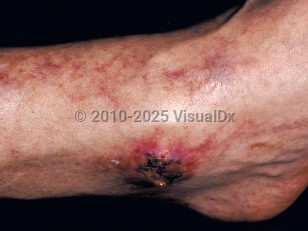Three subtypes of cryoglobulins are characterized, according to immunoglobulin type:
- Type I cryoglobulins (10%-15% of cases) are monoclonal cryoglobulins typically made of IgM and sometimes IgA or IgG. Type I cryoglobulinemia is associated with B-cell lymphoproliferative disorders (most commonly multiple myeloma and Waldenström macroglobulinemia). The monoclonal cryoglobulins precipitate at lower temperatures, leading to vascular occlusion and ischemic damage of tissues. Typically, acral areas are affected.
- Type II (50%-60% of cases) and type III (30%-40% of cases) cryoglobulins are mixed cryoglobulins that consist of a rheumatoid factor (IgM) complexed with either a monoclonal IgG (type II) or a polyclonal IgG or non-immunoglobulin serum component (type III). Mixed cryoglobulinemias are caused by chronic B-cell activation that leads to immune complex formation (IgM / IgG) and deposition in small and medium vessels, resulting in vasculitis. The majority of cases (80%-90%) are associated with chronic hepatitis C virus (HCV) infection. Other infections (hepatitis B virus, HIV, Epstein-Barr virus, cytomegalovirus, leprosy, and, more rarely, other viral, bacterial, and parasitic infections) and rheumatological conditions (systemic lupus erythematosus, rheumatoid arthritis, and Sjögren syndrome) have also been associated. Due to chronic B-cell stimulation, cryoglobulinemia is associated with the development of malignant B-cell lymphoproliferative disease, in particular non-Hodgkin lymphoma (35 times higher risk than the general population). When no underlying cause is identified, it is designated as essential mixed cryoglobulinemia.



